Menus
- Efficient charmer
- Discovery
- In the saddle
- In the city
- Motorway and expressways
- Departmental
- Part-cycle
- Braking
- Comfort / Duo
- Consumption
- Conclusion
- Colors
- Accessories
Efficient charmer
Alongside its NC700s (New Concept), Honda presented in 2012 a hybrid machine, very close in part-cycle and mechanical parts of its cousins. Innovative synthesis between motorcycle and maxi-scooter, hence its name, the machine mixes the advantages and limitations of both worlds and is equipped with the DCT robotic automatic gearbox.. At the time, the winged firm explained that it sought less raw performance than that of low-speed approval and the lowest possible fuel consumption. As a corollary of this design, the maximum power is then only 52 hp (38.5 kW) at 6,250 rpm but 6.2 da.Nm from 4,750 rpm. In 2014, like the NC range, the motoscoot inflates its twin-cylinder to 745 cm3, gaining a little mechanical personality.
Guided by the theme "Sensual Performances, the 2016 Integra is only developing little aesthetically. And if it does not gain in practicality either, the transgenic Honda seduces with new dynamic services..
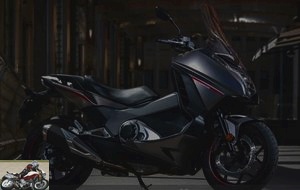
Discovery
Particularly refined, the style of the Integra draws its strength both from its design and from its motorcycle wheels. This improbable encounter brings an elegant power to the concept. Dynamic, the angular design of the optics framed by sidewalls forming long scoops muscle the front. Around the central optic, two lines of LED daytime running lights reinforce its visual signature. The side fairings feature a slightly revised design, a flared line energizing their surface. The whole is surmounted by a long windshield, wide and perforated at its base in order to minimize turbulence. Mimicking a titanium-colored frame, the central tunnel covers stretch the silhouette of the maxi-scoot towards a long rider saddle.
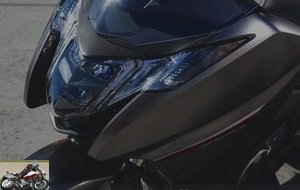
Next to it, a cylinder allows it to be lifted, freeing up access to the orifice of the 14.1-liter tank and to a storage space. Still too small, it cannot accommodate a helmet, even a jet type helmet. Flanked by large grab handles, the passenger seat is smaller. Everything almost seems to levitate on a rear loop as fluid as it is sporty, with sharp volumes..

This rather chic set is supported by a tubular diamond-like steel frame carrying the 745cc inline twin with 8 valves. Its tilted 62 ° forward position places the unit very low, thus allowing its use in a scooter. The twin is very compact. Mono-injector, single camshaft driving the water pump and two balance shafts, one of which operates the oil pump. A guarantee of character, its crankshaft set at 270 ° and a stroke of 80 mm for a bore of 77 mm give pride of place to the couple, present from low revs. The twin still develops 55 hp at 6,250 rpm and a force of 6.8 da.Nm at 4,750 revolutions / minute and complies with Euro 4 standards.
A double-clutch, limited-slip DCT robotic gearbox assists the Honda boiler. One element controls 1/3/5 ratios and the other controls 2/4/6. Each operates alternately, independently controlled by its own electro-hydraulic circuit. When changing gear, the electronic control unit detects the movement of the control and engages the next gear. It then releases the clutch from the previous gear while engaging the gear clutch. The staging is shorter than that of the trail NC750X DCT. Finally, the chain transmission, motorcycle type requires, is not a real drawback, but requires regular lubrication..

This electronics is further optimized in 2016, bringing more speed and smoothness in the transitions. Thus, the manual mode M, D evolves according to the piloting and the sport modes S are made more precise. Now three in number, these should allow a more precise match with the management adopted and the situations encountered. Finally, the system detects the phases of driving up or down and adapts the operation of the selection accordingly. Accessible at any time, the + and – selection triggers further refine the possibilities and now allow downshifts higher in the laps (in sport mode).
Shorter, the exhaust resumes that of the new NC750X sporty style and loses 0.5 kg. Its multi-faceted volumes are dressed in a strapping and a perforated aluminum side protection. Inside, two expansion volumes are connected by a perforated pipe opening into a resonance chamber.
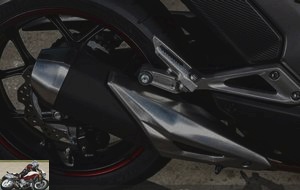
Discreet and slim, the stylish passenger footrest plates blend in perfectly with the whole and contribute to the overall elegance. A neat aesthetic also by the use of an aluminum foundry swing arm, managed by a shock absorber now adjustable in preload. Like the Trail NC, the Integra sports a 41mm Showa Dual Bending Valves (SDBV) telescopic fork. This double-acting valve system generates a damping force precisely matched to the speed of the piston. Devoid of adjustment, the compression and rebound damping of the front axle benefits from new laws. Front and rear offer 153mm and 150mm travel.
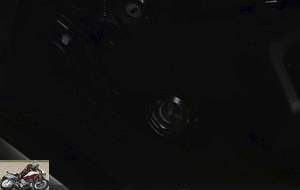
The geometry does not change, with a column angle fixed at 27 ° and a trail of 110 mm. If the length increases by 20 mm, the wheelbase remains the same at 1,525 mm. The mass of the hybrid, 238 kg is distributed 50/50% on the wheels.
Precisely, camped on 17-inch rims, the Integra thus presents its most striking singularity. Their glossy black surface and the adoption of angled valves finalize an excellent finish. In aluminum with 5 Y-shaped branches, they receive Bridgestone Battlax T30F casings in 120 and 160. To slow down their rotation, the brake system consists of a front and rear single disc brake with petal frets. A dual piston caliper bites the 320mm front track, a single piston element grips the opposing 240mm disc. Standard ABS watches over everything.
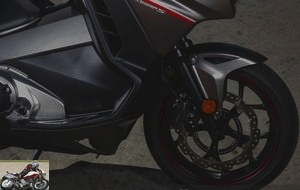
Particularly rewarding, our test model in the Special Edition version has a matte metallic silver tint, enhanced with side piping and on its rims. The central stand is standard, as is the 12V socket. On the other hand, the absence of anti-slip is surprising.
In the saddle
Admittedly, the central tunnel is higher than usual on a maxi-scoot. It is necessary to accommodate the twin and this arrangement does not interfere with comfort. Accessible, the comfortable saddle rises to 790 mm. The arms then fall naturally on the handles of a streamlined handlebar. These surfaces hide the pretty alunite gray fork caps. Above, buried in the cockpit, the LCD screen regrouping the instruments seems a little low to me. Above all, its readability is surprisingly reduced by the shadow cast. In full sun, it is much brighter. Finally, this analog window would gain in readability by expanding its dimensions. Complete, the negative display includes digital tachometer and tachometer, odometer and two trips, fuel gauge, average and instantaneous consumption indicator, on-board watch, gear indicator engaged and DCT mode selected.
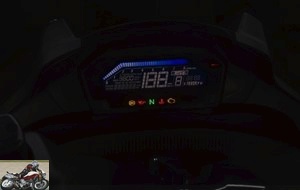
The display color can be adjusted from 9 choices. These can be modified according to the selected speed, the speed range or the driving mode. If a single display color or function of the selection mode is selected, two additional options are available: ECO or SHIFT modes. The first offers a light blue display when driving is normally sober and green so economical. In SHIFT mode, the display color changes to orange if the engine speed exceeds a threshold previously set by the user. However, all these manipulations are hardly ergonomic. More pleasant, the levers are adjustable in spacing and a parking blocking system is located on the right, in the fairing. On the left, a small storage box is, unfortunately, without a key lock.
In the city
As on the NC750X trail, the Integra exhaust gives off tonic pulsations. Mechanics and gearbox are particularly smooth and the softness of the controls offers a natural grip. Benefiting from an excellent balance, the Honda motoscoot proves to be very agile in traffic and steers with the tips of the gloves. On board, who would then suspect such large rims ?
Powerful and progressive, the brake calipers respond to any demand. Ideally calibrated, the ABS is perfect for avoiding everyday unforeseen events and without tripping unnecessarily.
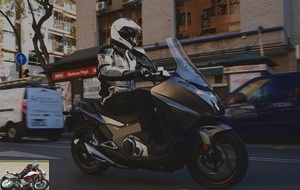
In D mode, the electronics take care of consumption and shift gears from 2,000 rpm. Responsive and jerk-free, DCT selection is significantly more efficient. To those who would oppose an even more perfect operation of a variator, we will oppose the much greater versatility of the DCT box. Modular at any time by the dedicated triggers, the selection allows a much better management of the mechanics. And in sport mode 3, the dynamics are as convincing as that of the benchmark of the genre, the Yamaha Tmax 530. Enough to hit the tricolor race and win the cup…. or plum. And pay attention to the torque during re-acceleration. Without anti-slip, the rear wheel can slip on the angle in cold or wet weather when go-around too quickly. The engine response is more lively and the electronics then shifted gears to 4,500 revolutions / minute. To keep this rhythm, we will leave this cramped environment to breathe the twin.
Motorway and expressways
At high speed, the large wheels of the Integra provide remarkable stability and we cruise quickly at an unjustifiable pace (maximum 180 km / h). Because the protection of the windshield is very correct. Especially at 130 km / h where most of the body including head is protected. Always quick to revive the crew, the twin vibrates little and the comfort is very good. Only boredom awaits and we are impatient to test the Honda hybrid on the winding…
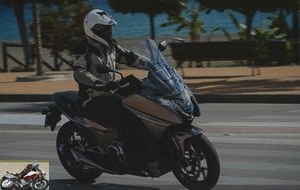
Departmental
Speed and serenity accompany the evolutions on the road. In sport mode 2 or 3, the scooter pushes to play. Always set on the right gear to restart the machine, the gearbox is again very smooth and quick. When decelerating, it then provides engine braking useful for sporty driving. And do not think that the D mode is figuring. Because the latter is intelligent, learning your riding style. A little less reactive, it is more pleasant as soon as you cross a small town.

Agile and endowed with little inertia, the Integra moves pleasantly in the ferrule, barely limited by its (good) ground clearance. Its motorcycle geometry works wonders and brings a lot of naturalness to the movement. The rise in 160 at the rear is no stranger to this behavior.
Another factor of efficiency, the new suspensions are very convincing, filtering the defects of the bitumen and delivering flawless handling. Thus, the SDBV fork provides appreciable progressiveness and keeps the Integra on its trajectory..
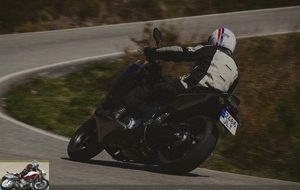
The front brake is all the more efficient and controllable, but the simple disc may show some limits on large decelerations at high speed. Less pleasant, the rear clamp is sometimes a little dry and less progressive. It is not uncommon to initiate a wheel lock when cornering if you are a little violent on the lever..
When driving for tourists, we also benefit from the hybrid design of the NC750 D Integra. The obviousness of its handling and the quality of the automatic selection almost make you forget the machine. But to ride far, plan to have a top case and suitcases ….
Part-cycle
Rigorous and agile, the Integra is as pleasant in the city as it is efficient in peri-urban areas. Its quality fork effectively limits transfers and provides a good feeling of the front axle. Stable and responsive, its mixed design allows it to tackle long journeys without any harm.
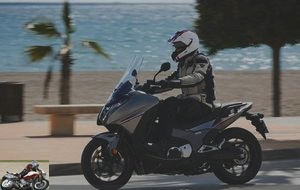
Braking
Powerful and enduring, the braking system adapts to any type of driving. At high speed, the single disc can be limited in duet. When turning, the grip of the lever controlling the front gently lifts the machine. The rear is less measurable if you are careful, but effective. Likewise, ABS is discreet and its implementation relevant.
Comfort / Duo
Welcoming to the crew, the Integra is comfortable. The suitcases and / or top-case option is however unstoppable. Likewise, heated grips will be a worthwhile investment for a vehicle that is often used in all seasons..
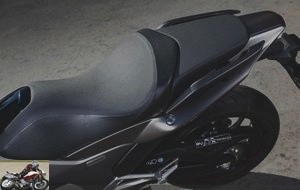
Consumption
With an average of 4.1 liters per 100 km in more road use than urban use, the NC750 Integra displays appreciable sobriety. A figure easily reduced by 0.5 liters in more urban driving.
Conclusion
Statutory, but not ostentatious, the Honda NC750 D Integra cultivates an appreciable dynamic elegance, enhanced by a significantly optimized DCT robotic selection. Handling is still improving, adding to the stability of its 17-inch wheels the rigor of an effectively damped front end. As on the NC750X trail, we will regret the absence of anti-skating so important in town as further afield.
Priced at € 9,249 in the standard version (€ 9,449 for our special series), the Integra increases a little in price (+ € 248), but provides increased approval. We will oppose him the Yamaha T-Max 530 ABS at 10,999 €, with an even more racy look and sports chassis. However, the Integra has little to envy it in dynamics. More opulent, the Suzuki Burgman 650 is also much more spacious. Claiming € 9,999 at the entry level, its size can nevertheless represent a weak point.
Efficient and stylish, equipped with extraordinary DCT technology, the NC750 D Integra remains a vehicle apart, intuitive and dynamic.
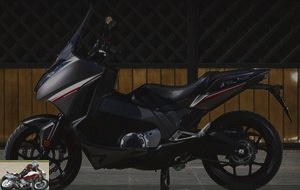
Strong points
- Seductive style
- Engine character and availability
- Exhaust sound
- Agility and precision of the chassis
- Comfort
- Finishes
Weak points
- Lack of anti-slip
- Still limited logeability
Honda Integra 750 SP technical sheet
Test conditions
- Itinerary : –
- Scooter mileage: –
- Encountered problem : –
Colors
- Matte Bullet Silver
- Black Matte Gunpowder Metallic
- Matte Majestic Silver Metallic (Special Edition)
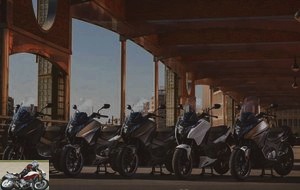
Accessories
- Parcel rack
- Hand guards
- Top-case 35 and 45 L
- 29 L side cases
- Inner bags
- Deflectors
- Heated grips
- U-lock
Related articles
-
Admirable vessel The VFR is the essential icon of a category that has fallen a bit into disuse today. Too bad, because this sixth generation pushes the…
-
Honda NC 700 X motorcycle test
Transgenic camel Discovered at the Milan Motor Show, the Honda range is enriched with a new range of 3 midsize machines, available on the same chassis…
-
Honda Africa Twin test in the mud
Three levels of traction control, disconnectable ABS, DCT: useful, or not ? A life-size test at the Honda Adventure Center in Wales A real commercial…
-
Dynamic Ecotrail Since 2011, the NC700 family has been trying to respond, each according to their specificities in the daily life of mostly peri-urban…
-
Honda Integra 750 maxi-scooter test
The biker scooter Apply to the motorcycle what the manufacturer was already doing for the car…. that is to say use a common base to decline several…
-
Two-wheeler SUV or land-based backpacker Recognized supplier of sometimes avant-garde innovations and yet producing machines regularly considered very…
-
GT-Cruiser of the 3rd type The winged builder keeps up his ideas and keeps revisiting the contemporary bagger style. After the F6B and very soon F6C,…
-
The small large gas turbine The brand’s historic sports car, the CBR 600 RR is a sure bet for efficiency and performance. Rather than the ultimate quest…
-
Road bike 173 horses Presented in early 2010 as the synthesis of Honda know-how, both mechanically, qualitatively and technologically, the VFR 1200 did…
-
Honda Africa Twin CRF1000L test
Honda CRF1000L Africa Twin ABS and DCT version Legends never die. Like the phoenix, the Africa Twin is reborn from the sand of its past exploits in a…
Sorry to contradict you Olivier but that has absolutely nothing to do with ZX-12R and Hayabusa are big turkeys next to the H2. In terms of the brutal surge of power, its availability from mid-range, and the lack of inertia to go high in the revs, the H2 is on another planet compared to what you mention….
For the record, I left on a full ZX-10R, after bringing the H2 back to Kawa France. 200 hp too (even 210 with the Ram-Air): however, it took me a few kilometers to convince myself that I was not on a ZX-6R. H2 is really something else … and an engineering delirium too !
Philippe